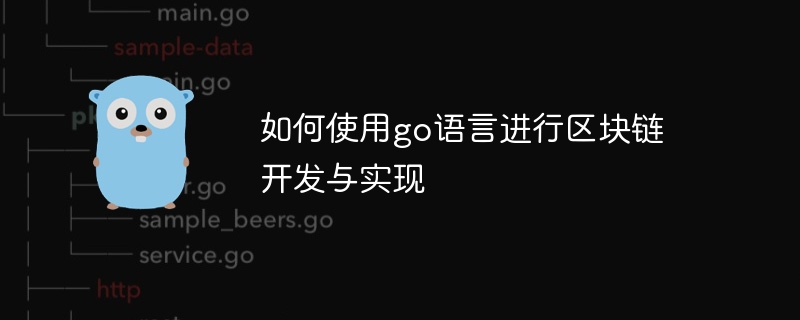Home >Backend Development >Golang >How to use go language for blockchain development and implementation
How to use go language for blockchain development and implementation
- WBOYWBOYWBOYWBOYWBOYWBOYWBOYWBOYWBOYWBOYWBOYWBOYWBOriginal
- 2023-08-08 23:12:291285browse

How to use go language for blockchain development and implementation
Blockchain technology has attracted much attention in recent years. It is decentralized, cannot be tampered with, and is anonymous. It has characteristics such as security and is widely used in digital currency, smart contracts and other fields. As an efficient and highly concurrency programming language, Go language provides great convenience for blockchain development. This article will introduce how to use Go language to develop and implement blockchain, and provide some code examples.
- Initialize the blockchain structure
First, we need to create a blockchain structure, including a series of blocks. Each block in the blockchain contains a set of transactions and the hash of the previous block.
type Block struct {
Index int
Timestamp string
Data []byte
PrevHash []byte
Hash []byte
}
type Blockchain struct {
Blocks []*Block
}- Generate genesis block
The genesis block is the first block in the blockchain. It has no reference to the previous block. By defining a genesis block, we ensure that the starting point of the blockchain is always certain.
func InitBlockchain() *Blockchain {
return &Blockchain{[]*Block{createGenesisBlock()}}
}
func createGenesisBlock() *Block {
return &Block{0, "01/01/1970", []byte("Genesis Block"), []byte{}, []byte{}}
}- Add block
When a new transaction occurs, we need to add a new block to the blockchain. Before creating a block, you need to calculate the hash value of the previous block and use it as the previous hash value of the current block.
func (bc *Blockchain) AddBlock(data []byte) {
prevBlock := bc.Blocks[len(bc.Blocks)-1]
newBlock := generateBlock(prevBlock, data)
bc.Blocks = append(bc.Blocks, newBlock)
}
func generateBlock(prevBlock *Block, data []byte) *Block {
newBlock := &Block{}
newBlock.Index = prevBlock.Index + 1
newBlock.Timestamp = time.Now().String()
newBlock.Data = data
newBlock.PrevHash = prevBlock.Hash
newBlock.Hash = generateHash(newBlock)
return newBlock
}- Calculate block hash value
Each block contains a hash value, which is based on the content of the block and the hash of the previous block The hash value is calculated. We can use SHA256 algorithm to calculate the hash value.
func generateHash(block *Block) []byte {
record := strconv.Itoa(block.Index) + block.Timestamp + string(block.Data) + string(block.PrevHash)
h := sha256.New()
h.Write([]byte(record))
hash := h.Sum(nil)
return hash
}- Test the blockchain
We can write a test function that calls the above function and outputs the block information in the blockchain.
func main() {
blockchain := InitBlockchain()
blockchain.AddBlock([]byte("This is the first block"))
blockchain.AddBlock([]byte("This is the second block"))
for _, block := range blockchain.Blocks {
fmt.Println("Index:", block.Index)
fmt.Println("Timestamp:", block.Timestamp)
fmt.Println("Data:", string(block.Data))
fmt.Println("PrevHash:", block.PrevHash)
fmt.Println("Hash:", block.Hash)
fmt.Println()
}
}Through the above steps, we can use Go language to develop and implement blockchain. Of course, blockchain technology still has many complex parts, such as mining, consensus algorithms, etc. This article only provides a basic implementation solution. I hope this article will be helpful to you in learning and exploring blockchain technology!
The above is the detailed content of How to use go language for blockchain development and implementation. For more information, please follow other related articles on the PHP Chinese website!

